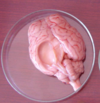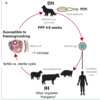Taeniid Cestodes Flashcards
Significance of taeniids
livestock and meat industry
some zoonotic
clinical disease (humans)
Public health impact
What is a cysticercosis
Cyst in the IH

Random taenia facts
- Branched uterus
- unpaired genitals
- genital pores in irregular sequence on either side
Types of larval cysts
Cysticercus-> cysticercosis - Taenia
Coenurus-> coenuriasis - other Taenia
Hydatid-> hydatidosis - Echinococcus spp
Taenia solium (pork measles worm) lifecycle and host
Egg -> Oncosphere -> Cysticercus (pig, humans, muscles/CNS) -> adult (humans)
Features of Taenia solium
- usually only 1 adult in SI (ie. solium)
- 5-10m long
Laval stage of Taenia solium
Affinity
Cysticercus cellulosae
Oncosphere carried in blood stream to brain, muscles and subcutis tissue. Affinity for nervous tissue
Taenia saginata IH
and DH
Cattle; musculature
Humans
Taenia saginata common name
size
larval stage name and distribution
beef measles worm
5-15m
Cysticercus bovis in muscles.
Lifecycles of human Taenia

Which Taenia?

Taenia saginata
Which Taenia?

Teania solium
IH of Taenia ovis
Sheep, goat; musculature
DH of Taenia ovis
canid; dog and fox
Features of Cysticercus ovis
mostly in heart, diaphragm and masseter muscles
Cysts rapidly degenerate to form granulomas
What has caused these lesions?

Taenia hydatigena
IH of Taenia hydatigena
Ungulates; liver+omentum
DH of Taenia hydatigena
canid
Common name of Taenia hydatigena
False hydatid worm
Cysticercus tenuicollis (from T. hydatigena) features
attached to omentum in sheep, cattle, pigs.
oncosphers burrow through liver for 1 month -> peritoneal cavity and establishes in omentum
may lead to Black Disease
- liver condemnation
Taenia pisiformis IH
Rabbit, hares; liver+omentum
DH of T. pisiformis
canid
Cysticercus forming Taenia
T. solium
T. saginata
T. ovis
T. hydatigena
T. pisiformis
T. taeniaeformis
DH of T. taeniaeformis
Felid
IH of T. taeniaeformis
rats, mice; liver
Larval stage of T. taeniaeformis
Strobilocercus fasciolaris
What is a cysticercus
Fluid filled sac with a protoscolex
What is a coenurus?
Many protoscolex on the internal surface of a fluid filled sac
What is a hydatid?
A fluid case with more coenuri within it
What taenia form coenurus?
T. multiceps
T. serialis
Lifecycle stages of Taenia multiceps
Egg -> Oncosphere -> Coenurus (ungulates; CNS) -> adult (canid)
Disease caused by T. multiceps
Progressive (6-8 months) -> incoordination, head pressing, blindness
Differentials of T. multiceps
Listeriosis, parelaphostrongylosis, scrapie, ‘mad cow’
What caused this lesion?

T. multiceps
Where is T. multiceps found?
New Zealand, UK
not in Aus
IH host of T. serialis
rabbits, hares; subcutaneous
Type of cyst?
From what species?
Coenurus
T. serialis
DH of T. serialis
canid
What causes hydatid cysts?
Echinococcus
Alveolar echinococcosis is caused by?

Echinococcus multilocularis
Cystic (unilocular) echinococcosis is caused by?

Echinococcus granulosus
Lifecycle of Echinococcus granulosus + epidemiology
Endemic in Aus
Has domestic (pig, sheep, cattle) and sylvatic (kangaroo) cycles

Common name of Echinococcus granulosus
Hydatid tapeworm
Size og Echinococcus granulosus
how many segments?
How many strains?
2-5mm
3-5 segments
9 strains
Pathology of Echinococcus granulosus in canids
No pathology and no protective immunity
Pathogenesis of E. granulosus in IH
Primary hydatidosis - pressure atrophy and collateral circulation
Secondary hydatidosis (rupture) - Anaphylactic shock due to a huge amount of antigen formed
How to treat hydatidosis?
Surgical removal - have to drain cycsts first
Benzimidasols have low efficacy
Lifecycle of Echinococcus multilocularis
Alveolar hydatid in rodents/humans
Egg -> oncosphere -> alveolar hydatid -> adult

Features of the larvae
Invasive and metastatic properties. Therefor surgical excision is almost impossible.
Distribution of E. multilocularis
Not in Aus



